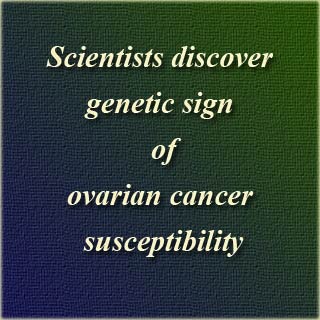
Scientists were believed to have investigated through the genomes of nearly 1,810 women with ovarian cancer and approximately 2,535 women without the disease from all over the UK. They analyzed about 2.5 million variations in DNA base pairs. Apparently, the letters spelt the genetic code in order to recognize common spelling ‘errors’ which is associated to ovarian cancer risk.
The scientists identified the genetic ‘letters’ which was also called single nucleotide polymorphisms (SNPs). SNPs when spelt slightly in a different way could increase ovarian cancer risk in some women. It was noted that this is the foremost time when scientists have found a SNP linked uniquely to the chances of ovarian cancer. In addition, the study took total eight years of investigations.
Also, through the assistance of the international Ovarian Cancer Association Consortium (OCAC), they then examined more than 7,000 additional women with ovarian cancer and around 10,000 women without disease from around the world in order to confirm this finding.
Supposedly, the region of risk DNA is located on chromosome nine. It is known that there are 23 pairs of each chromosome in humans, one of each pair inherited from each parent. Women carrying the DNA variation on both copies of chromosome nine seem to be at 40 percent increase chances of developing ovarian cancer in contrast to someone who doesn’t carry it on either chromosome.
Approximately 15 percent of women in the UK population are believed to carry two copies of the variant DNA. In addition, the lifetime risk for a woman carrying the DNA variant on one copy of the chromosome seems to have increased by 20 per cent from ten in 1000 to 12 in 1000. About 40 percent of women in the UK are noted to carry one copy.
Senior author Dr Simon Gayther, stated that, “The human DNA blueprint contains more than 10 million genetic variants. These are part and parcel of our characteristics and make-up – but a handful will also increase the chances of some women getting ovarian cancer and we have found the first one of these.â€
“This study confirms that ovarian cancer risk is partly determined by genetic variants present in a large number of women. This initial discovery and others that will likely follow in the future lay the groundwork for individualized early detection and prevention approaches to reduce deaths from ovarian cancer,†says Dr Andrew Berchuck, head of the international Ovarian Cancer Association Consortium steering committee.
It was noted that ovarian cancer is the fifth most common cancer in women in the UK. In addition, about 6,800 novel cases seemed to be diagnosed every year in the UK. Apparently, it is the fourth most common cause of cancer death in women in the UK with around 4,300 deaths from the disease in the UK each year.
Dr Lesley Walker, director of cancer information at Cancer Research UK, elucidated that, “This is an important discovery. Our researchers have worked as part of a huge collaboration to establish the regions of DNA that can increase someone’s risk of developing ovarian cancer. This research paves the way for scientists to discover even more genes linked to ovarian cancer and could lead to new approaches to treat or prevent the disease – crucially it will help doctors manage women who are at increased risk.â€
BRCA1 and BRCA2 are believed to be high risk genes which cause breast cancer. Also, they are known to significantly increase the risk of ovarian cancer. However, errors in these genes seem to be rare and may possibly cause less than five per cent of all cases of ovarian cancer.
The findings of the research have been published in Nature Genetics.

